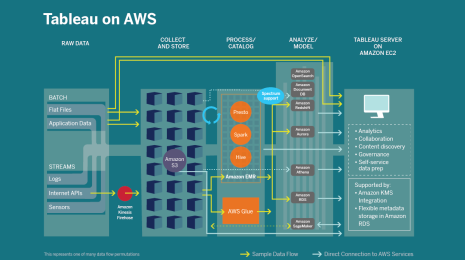Self-Service Analytics for Google Cloud, now with Looker and Tableau
It's more important than ever in this all digital, work from anywhere world for organizations to use data to make informed decisions. Speed, agility, and empowerment are crucial to thriving in this new environment. However, most organizations struggle to become data driven. Data is stuck in siloes, infrastructure can’t scale to meet growing data needs, and analytics is still too hard for most people to use.
Tableau and Google Cloud are partnering to help modernize your data and analytics infrastructure and unlock your data’s full value. Google's Cloud Platform is the enterprise solution of choice for many organizations with large and complex data problems. With Tableau, any user can visually explore that data in real time. With no need to move data to in-memory storage, you can connect to and analyze data wherever it lives, taking full advantage of Google Cloud’s computing capacity—and providing an end-to-end analytics solution. This helps all kinds of customers—from large retailers like Woolworths, to healthcare organizations like Health Data Compass—scale modern analytics with Tableau and Google Cloud.
We keep innovating together to scale analytics to anyone across your organization. Read on to learn more:
- Tableau is integrating with Looker to help customers connect with governed data and build a flexible data environment that scales and adapts with their evolving needs.
- Tableau and Google Cloud are working together to make data more accessible and more valuable with integrations between our world-class analytics and the Google applications that power your business.
- Tableau and Google Cloud support your digital transformation by leveraging the power and flexibility of the cloud and help unlock more value from your data, no matter where you are in your cloud migration.
Governed, self-service with Tableau and Looker
We are excited for the next phase of the Tableau and Google Cloud partnership, including plans for deeper integration between Tableau and Looker. Leveraging Looker’s semantic layer will provide Tableau customers with trusted, governed data at every stage of their analytics journey. With its LookML modeling language, Looker provides a unique, modern approach to define governed and reusable data models to build a trusted foundation for analytics. This modeling language creates a centralized semantic layer for an organization’s business rules and definitions, but does it in an agile fashion consistent with modern software engineering best practices. Connecting directly to this semantic layer will help give customers access to critical business data in a safe, governed manner.
“This partnership makes data more accessible and trusted. With Looker’s secure, trusted and highly performant data governance capabilities, we can augment Tableau’s world-class data visualization capabilities to enable data-driven decisions across the enterprise. We look forward to continued collaboration that will open up new opportunities for users to take their analytics to the next level in the cloud,” said Gerrit Kazmaier, Vice President & General Manager for Database, Data Analytics and Looker at Google Cloud.
Learn more: Google shared additional details in today’s Google Cloud Next keynote.

Your data in the cloud
Analytics starts with data, which is why connecting to data has been the focus of much of Tableau’s integrations with Google Cloud. Our continued investments in connectivity with Google technologies help ensure your data is secure, governed, and scalable.
Direct connection to Google BigQuery
Tableau’s lightning-fast Google BigQuery connector allows customers to engineer optimized data pipelines with direct connections that power business-critical reporting. Zulily is a great example, having unlocked customer acquisition insights to empower teams to optimize ads, emails, and offers. Our BigQuery connector also supports BigQuery tables managed by Google’s BI Engine, which helps optimize query performance and dashboard load times.
Additionally, Tableau allows customers using BigQuery ML to easily visualize the results of predictive machine learning models run on data stored in BigQuery. This minimizes the amount of SQL you need to write to create and execute models, as well as analyze the results—making machine learning techniques easier to use.
We recently added support for Service Accounts to our BigQuery connector (in Tableau 2021.3), a critical feature for many customers using Tableau with BigQuery. Service Accounts give your IT team more control over data access and make it easier to manage this access at scale across entire organizations. We also continually improve our connector, adding support for new data types like BIGNUMERIC (in Tableau 2021.2) to address more customer use cases.
Operationalizing Tableau Prep flows to BigQuery
Our customers also need a way to easily clean, organize and distribute this data. Tableau Prep allows you to combine, reshape, and clean data using an easy-to-use, visual, and direct interface. Tableau Prep now includes the ability to output data directly to Google BigQuery, so you can automatically add or update data in your database with clean, prepped data from your flow.
Intuitive analysis and faster insights across Google applications
Customers who leverage Google BigQuery for their data warehousing needs frequently use other Google solutions throughout their organization. Together, Tableau and Google Cloud are helping customers pull value from their data at each touchpoint.
Marketing teams can use Tableau’s Google Ads and Google Analytics connectors to build intuitive reporting and get insights fast to make decisions when data is most relevant. Combining and analyzing Shopify and Google Analytics data helped eco-friendly retailer Koh improve customer retention by 25%.
Tableau users can connect directly to Google Sheets and Google Drive documents for fast, ad-hoc analysis in their day-to-day workflow. Google Sheets is one of the most popular data sources for Tableau Public, our free, web-based software, where daily refreshes keep visualizations up-to-date automatically. From journalists and educators to sports and entertainment enthusiasts, Tableau Community members around the world use Google Sheets and Tableau Public to create and share impactful visualizations that inspire the art of the possible and resonate beyond the corporate sphere.
The cloud migration journey
As data moves to the cloud, analytics and other business apps typically follow. This “data gravity” is a driver for organizations adopting a cloud-first strategy and investing in SaaS solutions that require little maintenance and can scale with their evolving needs.
Flexible cloud analytics deployments
Tableau is guided by the principles of choice. Our platform will not dictate your data strategy or technology investments when it comes to your data sources and hosting preferences. And in the cloud, flexibility is an imperative. Tableau Online, our cloud-native analytics solution, is a logical pairing for customers adopting Google Cloud as their cloud data platform. Spending fewer resources on infrastructure management allows more focus on enabling self-service analytics across your organization.
Migrating to the cloud may mean adopting Tableau Online or deploying Tableau Server on cloud infrastructure. In either case, Tableau is committed to supporting your journey. We’ve collaborated with Google Cloud to publish a comprehensive whitepaper that addresses the intricacies of deploying Tableau Server on GCP infrastructure—including hardware sizing, scaling and security. We can even support deployments for many healthcare customers with unique data privacy needs helping with HIPAA compliance.
Optimizing cloud spend
While digital transformation may begin with a “lift and shift,” it often evolves into a “move and improve” operation where organizations seek to optimize their investments in the cloud. We believe every cloud migration should incorporate transparency and smart data usage from the beginning. This is why we built a custom suite of Tableau dashboards you can use right out of the box to monitor your cloud spend.
More to come from this innovative partnership
We're able to invest significantly in our platform integrations in large part due to our strong partnership with the Google Cloud team. And we're not stopping here. Tableau and Google Cloud will continue to innovate together, scale customer success, and help every organization become data driven.
Want to learn more about how Tableau and Google Cloud work together? Visit our Google solutions page.
Related Stories
Subscribe to our blog
Get the latest Tableau updates in your inbox.









